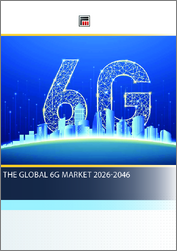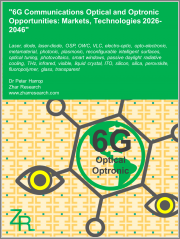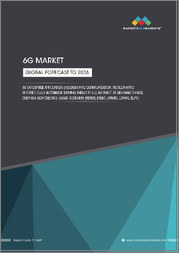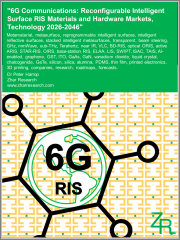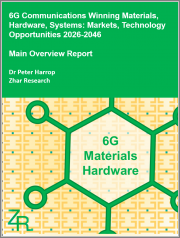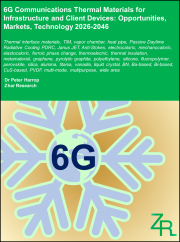
|
시장보고서
상품코드
1843997
세계의 6G 시장 보고서(2025년)6G Global Market Report 2025 |
||||||
6G 시장 규모는 최근 급격히 확대되고 있습니다. 2024년 73억 2,000만 달러에서 2025년에는 94억 8,000만 달러에 달할 것으로 추정되고, CAGR 29.4%로 확대될 전망입니다. 성과 기간의 성장은 무선 연결의 진화, 데이터 수요 증가, 정부 및 산업계 투자, 새로운 이용 사례, 초신뢰 저지연 통신(urllc)으로 인한 것입니다.
6G 시장 규모는 향후 수년간 비약적인 성장이 예상됩니다. 2029년에는 CAGR 29.2%로 성장할 전망이며, 263억 8,000만 달러로 성장이 예측됩니다. 예측 기간의 성장은 지속가능하고 환경친화적인 커뮤니케이션, 스펙트럼 혁신, 보안 및 프라이버시 우려, 세계 표준화 노력, 업계 특유의 요건으로 인한 것으로 예측됩니다. 예측 기간 세계 동향에는 신기술의 통합, 국제 협력, 세계 디지털 변혁, 기술 진보, 테라헤르츠(thz) 통신 등이 포함됩니다.
6G는 6세대 셀룰러 네트워크를 나타내며 무선 통신 기술의 다음 단계를 나타냅니다. 이러한 발전은 데이터 전송 용량을 향상시키고, 모바일 장치를 음성 및 움직임을 통한 상호작용을 지원하며, 홀로그램 미팅을 가능하게 하는 다목적 도구로 전환하는 것을 목표로 합니다.
6G의 기본 요소는 하드웨어, 소프트웨어, 서비스로 구성됩니다. 하드웨어에는 입력, 출력, 기억, 통신, 처리 등의 기본 기능을 실현하는 외부 기기 및 내부 기기가 포함됩니다. 이 카테고리에는 네트워킹 장치, IoT 및 엣지 컴퓨팅 장치, 모바일 장치 등 다양한 장치가 포함됩니다. 이러한 컴포넌트는 디지털 트윈, 블록체인, 스마트 시티 등 다양한 용도를 활용합니다. 최종 사용자는 농업, 자동차, 헬스케어, 정부, 제조업 등 다양한 분야에 이릅니다.
2025년 봄, 미국 관세의 급상승과 이에 따른 무역 마찰은 정보 기술 분야, 특히 하드웨어 제조, 데이터 인프라, 소프트웨어 전개에 큰 영향을 미쳤습니다. 수입 반도체, 회로 기판, 네트워크 장비에 대한 관세 인상은 하이테크 기업, 클라우드 서비스 공급자, 데이터센터의 생산 및 운영 비용을 밀어 올리고 있습니다. 노트북, 서버, 가전제품 부품을 세계로 조달하고 있는 기업들은 리드 타임의 장기화와 가격 압력에 직면하고 있습니다. 동시에 특수 소프트웨어에 대한 관세와 주요 국제 시장의 보복 조치로 세계 IT 공급망이 혼란스럽고 미국 기술에 대한 해외 수요가 줄어들고 있습니다. 이에 대응하기 위해, 이 분야는 국내 칩 생산에 대한 투자를 강화하고, 공급자 네트워크를 확대하며, AI를 활용한 자동화에 의해 회복력을 높이고, 비용 관리를 효율화하고 있습니다.
6G 시장 조사 보고서는 6G 업계의 세계 시장 규모, 지역 점유율, 6G 시장 점유율을 가진 경쟁업체, 상세한 6G 시장 부문, 시장 동향 및 비즈니스 기회 등 6G 시장 통계를 제공하는 The Business Research Company의 최신 보고서 시리즈 중 하나입니다. 이 6G 시장 조사 보고서는 업계의 현재 및 미래 시나리오를 자세히 분석하고 필요한 모든 것을 완벽한 관점에서 제공합니다.
향후 5년간의 성장률 29.2%라고 하는 예측은 전회 예측으로부터 0.1%라는 미감소를 반영하고 있습니다. 이 감소는 주로 미국과 타국가 간 관세의 영향 때문입니다. 이는 중국과 한국의 대학이나 기업과의 제휴가 지정학적 제약에 직면하기 때문에 초기 단계의 연구를 감속시키고 미국에 직접 영향을 줄 가능성이 높습니다. 또한 상호 관세와 무역 긴장 증가와 제한으로 인한 세계 경제와 무역에 대한 악영향으로 인해 그 영향이 더 광범위하게 늘어날 것으로 보입니다.
인터넷 연결성 향상은 6G 시장의 성장을 가속할 것으로 예측됩니다. 인터넷 접속성이란 개인이나 기기가 인터넷에 접속하여 데이터 액세스 및 통신을 가능하게 하는 기능을 말합니다. 인터넷 연결에서 6G는 인터넷 장치가 최대 1테라비트/초(TBPS)의 속도를 달성하고 엄청난 수의 장치가 연결되어 있어도 고효율, 안정적인 연결을 제공할 수 있도록 설계되었습니다. 예를 들어 2023년 10월 스위스에 본부를 두는 전문기관인 국제통신연합이 발표한 보고서에 따르면 현재 세계 인구의 약 67%에 해당하는 54억 명이 인터넷에 접속하고 있다고 합니다. 이는 2021-2022년 3.5% 증가에 비해 2022년 이후에는 4.7% 증가했습니다. 이처럼 인터넷 접속률 상승이 6G 시장을 전진시키고 있습니다.
6G 시장은 사물인터넷(IoT) 디바이스의 채용 증가로 큰 뒷받침을 받게 됩니다. 센서와 소프트웨어가 장착된 이러한 장치는 인터넷을 통해 데이터를 교환합니다. 예상되는 6G 데이터 전송 속도를 가속화하면 IoT 장치의 고속 전송을 촉진하고 증강현실(AR), 가상현실(VR), 고해상도 비디오 스트리밍 등 데이터 처리량이 필요한 애플리케이션에 이점을 제공합니다. 에릭슨의 2022년 11월 보고서에 따르면 광대역 IoT(4G/5G)는 2022년에 13억 연결을 달성했으며, 2028년 말에는 전체 셀룰러 IoT 연결의 60% 가까이까지 급증할 것으로 예상되고 있습니다. 이는 6G 시장의 성장을 가속하는 데 IoT 디바이스의 도입이 매우 중요한 역할을 한다는 것을 뒷받침합니다.
6G 시장에는 무선 감지, 확장 네트워크 정보 제공, 산업 공개 정보 등 기본 정보 서비스를 제공하는 기업이 얻는 수익이 포함됩니다. 시장 가치에는 서비스 제공업체가 판매하거나 서비스 제공에 포함된 관련 상품의 가치가 포함됩니다. 사업자간에 거래되거나 최종 소비자에게 판매되는 재화 및 서비스만 포함됩니다. 6G 시장은 무선 및 고정 셀룰러 인프라와 스마트 홈 디바이스 판매로 구성됩니다. 이 시장의 가치는 'Factory Gate'의 가치, 즉 다른 기업(다운스트림 제조업자, 도매업체, 유통업체, 소매업체 포함)이든 직접 최종 소비자이든, 상품 제조업체 또는 제작자가 판매한 상품의 가치입니다. 이 시장에서 상품의 가치에는 상품 제작자에 의해 판매되는 관련 서비스도 포함됩니다.
목차
제1장 주요 요약
제2장 시장 특징
제3장 시장 동향 및 전략
제4장 시장 : 금리, 인플레이션, 지정학, 무역전쟁 및 관세, 그리고 코로나 및 회복이 시장에 미치는 영향을 포함한 거시경제 시나리오
제5장 세계의 성장 분석 및 전략 분석 프레임워크
- 세계의 6G : PESTEL 분석(정치, 사회, 기술, 환경, 법적 요인, 촉진요인 및 억제요인)
- 최종 이용 산업의 분석
- 세계의 6G 시장 : 성장률 분석
- 세계의 6G 시장 실적 : 규모 및 성장(2019-2024년)
- 세계의 6G 시장 예측 : 규모 및 성장(2024-2029년, 2034년)
- 세계의 6G : 총 잠재 시장 규모(TAM)
제6장 시장 세분화
- 세계의 6G 시장 : 컴포넌트별 분석 및 예측(2019-2024년, 2024-2029년, 2034년)
- 하드웨어
- 소프트웨어
- 서비스
- 세계의 6G 시장 : 디바이스별 분석 및 예측(2019-2024년, 2024-2029년, 2034년)
- 네트워크 디바이스
- IoT 및 엣지 컴퓨팅 디바이스
- 모바일 디바이스
- 기타 디바이스
- 세계의 6G 시장 : 용도별 분석 및 예측(2019-2024년, 2024-2029년, 2034년)
- 디지털 트윈
- 블록체인
- 스마트 시티
- 세계의 6G 시장 : 최종 사용자별 분석 및 예측(2019-2024년, 2024-2029년, 2034년)
- 농업
- 자동차
- 헬스케어
- 정부
- 제조업
- 기타 최종 사용자 분야
- 세계의 6G 시장 : 하드웨어 유형별 세분화 분석 및 예측(2019-2024년, 2024-2029년, 2034년)
- 네트워크 인프라
- 사용자 장비
- 칩과 컴포넌트
- 기타 보조 기기
- 세계의 6G 시장 : 소프트웨어 유형별 세분화 분석 및 예측(2019-2024년, 2024-2029년, 2034년)
- 네트워크 관리 및 최적화
- 통신 프로토콜
- 데이터 분석 및 AI 플랫폼
- 보안 소프트웨어
- 애플리케이션 소프트웨어
- 세계의 6G 시장 : 서비스 유형별 세분화 분석 및 예측(2019-2024년, 2024-2029년, 2034년)
- 컨설팅 및 도입 서비스
- 매니지드 서비스
- 통합서비스
- 지원 및 유지 보수
- 트레이닝 및 교육
제7장 지역별 및 국가별 분석
- 세계의 6G 시장 : 지역별 분석 및 예측(2019-2024년, 2024-2029년, 2034년)
- 세계의 6G 시장 : 국가별 분석 및 예측(2019-2024년, 2024-2029년, 2034년)
제8장 아시아태평양 시장
제9장 중국 시장
제10장 인도 시장
제11장 일본 시장
제12장 호주 시장
제13장 인도네시아 시장
제14장 한국 시장
제15장 서유럽 시장
제16장 영국 시장
제17장 독일 시장
제18장 프랑스 시장
제19장 이탈리아 시장
제20장 스페인 시장
제21장 동유럽 시장
제22장 러시아 시장
제23장 북미 시장
제24장 미국 시장
제25장 캐나다 시장
제26장 남미 시장
제27장 브라질 시장
제28장 중동 시장
제29장 아프리카 시장
제30장 경쟁 구도 및 기업 프로파일
- 6G 시장 : 경쟁 구도
- 6G 시장 : 기업 프로파일
- Apple Inc : 개요, 제품 및 서비스, 전략 및 재무 분석
- Google LLC : 개요, 제품 및 서비스, 전략 및 재무 분석
- Samsung Electronics Co Ltd : 개요, 제품 및 서비스, 전략 및 재무 분석
- Verizon Communications Inc : 개요, 제품 및 서비스, 전략 및 재무 분석
- AT&T Inc : 개요, 제품 및 서비스, 전략 및 재무 분석
제31장 기타 주요 기업 및 혁신 기업
- Nippon Telegraph and Telephone Corporation(NTT)
- Huawei Technologies Co Ltd
- Sony Corporation
- T-Mobile US Inc
- LG Corporation
- Intel Corporation
- Cisco Systems Inc
- Orange SA
- Qualcomm Incorporated
- Mitsubishi Electric Corporation
- Broadcom Inc
- Fujitsu Limited
- Telefonaktiebolaget LM Ericsson
- Nokia Corporation
- NEC Corporation
제32장 세계 시장 경쟁 벤치마킹 및 대시보드
제33장 주요 인수합병(M&A)
제34장 최근 시장 동향
제35장 시장의 잠재력이 높은 국가, 부문 및 전략
- 6G 시장(2029년) : 새로운 기회를 제공하는 국가
- 6G 시장(2029년) : 새로운 기회를 제공하는 부문
- 6G 시장(2029년) : 성장 전략
- 시장 동향에 기초한 전략
- 경쟁 전략
제36장 부록
AJY 25.10.246G represents the sixth generation of cellular networks, marking the next phase in wireless communication technology. This progression aims to improve data transfer capacity, turning mobile devices into versatile tools capable of supporting interactions through voice or movement and enabling holographic meetings.
The fundamental elements of 6G comprise hardware, software, and services. Hardware encompasses both external and internal devices and equipment that facilitate essential functions such as input, output, storage, communication, and processing. This category includes various devices such as networking devices, IoT and edge computing devices, mobile devices, and others. These components leverage a range of applications, including digital twins, blockchain, and smart cities. End users span diverse sectors such as agriculture, automotive, healthcare, government, manufacturing, among others.
Note that the outlook for this market is being affected by rapid changes in trade relations and tariffs globally. The report will be updated prior to delivery to reflect the latest status, including revised forecasts and quantified impact analysis. The report's Recommendations and Conclusions sections will be updated to give strategies for entities dealing with the fast-moving international environment.
The sharp rise in U.S. tariffs and the ensuing trade tensions in spring 2025 are having a significant impact on the information technology sector, especially in hardware manufacturing, data infrastructure, and software deployment. Increased duties on imported semiconductors, circuit boards, and networking equipment have driven up production and operating costs for tech companies, cloud service providers, and data centers. Firms that depend on globally sourced components for laptops, servers, and consumer electronics are grappling with extended lead times and mounting pricing pressures. At the same time, tariffs on specialized software and retaliatory actions by key international markets have disrupted global IT supply chains and dampened foreign demand for U.S.-made technologies. In response, the sector is ramping up investments in domestic chip production, broadening its supplier network, and leveraging AI-powered automation to improve resilience and manage costs more effectively.
The 6G market research report is one of a series of new reports from The Business Research Company that provides 6G market statistics, including 6G industry global market size, regional shares, competitors with a 6G market share, detailed 6G market segments, market trends and opportunities, and any further data you may need to thrive in the 6G industry. This 6G market research report delivers a complete perspective of everything you need, with an in-depth analysis of the current and future scenario of the industry.
The 6G market size has grown exponentially in recent years. It will grow from $7.32 billion in 2024 to $9.48 billion in 2025 at a compound annual growth rate (CAGR) of 29.4%. The growth in the historic period can be attributed to wireless connectivity evolution, growing data demand, government and industry investments, emerging use cases, ultra-reliable low latency communication (urllc).
The 6G market size is expected to see exponential growth in the next few years. It will grow to $26.38 billion in 2029 at a compound annual growth rate (CAGR) of 29.2%. The growth in the forecast period can be attributed to sustainable and green communication, spectrum innovation, security and privacy concerns, global standardization efforts, industry-specific requirements. Major trends in the forecast period include emerging technologies integration, international collaboration, global digital transformation, technological advancements, terahertz (thz) communication.
The forecast of 29.2% growth over the next five years reflects a slight reduction of 0.1% from the previous projection. This reduction is primarily due to the impact of tariffs between the US and other countries. This is likely to directly affect the US by slowing early-stage research, as partnerships with universities and firms in China and South Korea face geopolitical restrictions. The effect will also be felt more widely due to reciprocal tariffs and the negative effect on the global economy and trade due to increased trade tensions and restrictions.
The increasing internet connectivity is expected to drive the growth of the 6G market. Internet connectivity refers to the capability of individuals or devices to connect to the Internet, enabling data access and communication. In the context of internet connectivity, 6G is designed to allow internet devices to achieve maximum speeds of one terabit per second (TBPS) and provide highly efficient and reliable connectivity, even with a vast number of connected devices. For example, in October 2023, a report published by the International Telecommunication Union, a specialized agency based in Switzerland, indicated that approximately 67 percent of the global population, or 5.4 billion people, are now online. This represents a 4.7 percent increase since 2022, compared to the 3.5 percent growth noted between 2021 and 2022. Thus, the rising internet connectivity is propelling the 6G market forward.
The 6G market is set to receive a significant boost from the increasing adoption of Internet of Things (IoT) devices. These devices, equipped with sensors and software, exchange data over the internet. The anticipated higher data rates of 6G will facilitate faster transmission for IoT devices, benefiting applications with demanding data throughput requirements, such as augmented reality (AR), virtual reality (VR), and high-resolution video streaming. According to a November 2022 report by Ericsson, broadband IoT (4G/5G) achieved 1.3 billion connections in 2022, with an expected surge to nearly 60% of all cellular IoT connections by the end of 2028. This underscores the crucial role of IoT device adoption in propelling the growth of the 6G market.
Major players in the 6G market are strategically focusing on adopting advanced technology products, utilizing software such as electronic design automation (EDA) software to anticipate 6G wireless communications development requirements. The electronic design automation (EDA) software suite facilitates automated design and verification of electronic circuits and systems. For example, in June 2023, Keysight Technologies Inc. launched PathWave ADS 2024, an EDA software suite addressing challenges in mmWave frequency bands for chip designers, enhancing simulation with faster 3D electromagnetic analysis, streamlined workflows for RF components, and improved electrothermal simulation for microwave power amplifiers.
In October 2023, Emerson, a US-based electric motor and fan manufacturer, completed the acquisition of National Instruments Corporation for $8.2 billion. This strategic move aims to strengthen Emerson's global automation leadership, expand its addressable markets, and capitalize on key secular trends in the industry. National Instruments Corporation, a provider of software-connected automated test and measurement systems, is involved in 6G technology research and development, further solidifying Emerson's position in the evolving landscape of 6G technology.
Major companies operating in the 6g market report are Apple Inc., Google LLC, Samsung Electronics Co Ltd., Verizon Communications Inc., AT&T Inc., Nippon Telegraph and Telephone Corporation (NTT), Huawei Technologies Co Ltd., Sony Corporation, T-Mobile US Inc., LG Corporation, Intel Corporation, Cisco Systems Inc., Orange SA, Qualcomm Incorporated, Mitsubishi Electric Corporation, Broadcom Inc., Fujitsu Limited, Telefonaktiebolaget LM Ericsson, Nokia Corporation, NEC Corporation, MediaTek Inc., ZTE Corporation, SK Telecom Co Ltd., Keysight Technologies Inc., Ciena Corporation, Rohde & Schwarz, Xilinx Inc., National Instruments Corporation, InterDigital Inc., DeepSig Inc
North America was the largest region in the 6G market in 2024. Asia-Pacific is expected to be the fastest-growing region in the forecast period. The regions covered in the 6g market report are Asia-Pacific, Western Europe, Eastern Europe, North America, South America, Middle East, Africa.
The countries covered in the 6G market report are Australia, Brazil, China, France, Germany, India, Indonesia, Japan, Russia, South Korea, UK, USA, Canada, Italy, Spain.
The 6G market includes revenues earned by entities by providing basic information services, including wireless sensing, enhanced network information provision, and public information of industry. The market value includes the value of related goods sold by the service provider or included within the service offering. Only goods and services traded between entities or sold to end consumers are included. The 6G market consists of sales of wireless and fixed cellular infrastructure and smart home devices. Values in this market are 'factory gate' values, that is, the value of goods sold by the manufacturers or creators of the goods, whether to other entities (including downstream manufacturers, wholesalers, distributors, and retailers) or directly to end customers. The value of goods in this market includes related services sold by the creators of the goods.
The market value is defined as the revenues that enterprises gain from the sale of goods and/or services within the specified market and geography through sales, grants, or donations in terms of the currency (in USD, unless otherwise specified).
The revenues for a specified geography are consumption values that are revenues generated by organizations in the specified geography within the market, irrespective of where they are produced. It does not include revenues from resales along the supply chain, either further along the supply chain or as part of other products.
6G Global Market Report 2025 from The Business Research Company provides strategists, marketers and senior management with the critical information they need to assess the market.
This report focuses on 6g market which is experiencing strong growth. The report gives a guide to the trends which will be shaping the market over the next ten years and beyond.
Reasons to Purchase
- Gain a truly global perspective with the most comprehensive report available on this market covering 15 geographies.
- Assess the impact of key macro factors such as geopolitical conflicts, trade policies and tariffs, post-pandemic supply chain realignment, inflation and interest rate fluctuations, and evolving regulatory landscapes.
- Create regional and country strategies on the basis of local data and analysis.
- Identify growth segments for investment.
- Outperform competitors using forecast data and the drivers and trends shaping the market.
- Understand customers based on the latest market shares.
- Benchmark performance against key competitors.
- Suitable for supporting your internal and external presentations with reliable high quality data and analysis
- Report will be updated with the latest data and delivered to you within 2-3 working days of order along with an Excel data sheet for easy data extraction and analysis.
- All data from the report will also be delivered in an excel dashboard format.
Where is the largest and fastest growing market for 6g ? How does the market relate to the overall economy, demography and other similar markets? What forces will shape the market going forward, including technological disruption, regulatory shifts, and changing consumer preferences? The 6g market global report from the Business Research Company answers all these questions and many more.
The report covers market characteristics, size and growth, segmentation, regional and country breakdowns, competitive landscape, market shares, trends and strategies for this market. It traces the market's historic and forecast market growth by geography.
- The market characteristics section of the report defines and explains the market.
- The market size section gives the market size ($b) covering both the historic growth of the market, and forecasting its development.
- The forecasts are made after considering the major factors currently impacting the market. These include:
The forecasts are made after considering the major factors currently impacting the market. These include the technological advancements such as AI and automation, Russia-Ukraine war, trade tariffs (government-imposed import/export duties), elevated inflation and interest rates.
- Market segmentations break down the market into sub markets.
- The regional and country breakdowns section gives an analysis of the market in each geography and the size of the market by geography and compares their historic and forecast growth.
- The competitive landscape chapter gives a description of the competitive nature of the market, market shares, and a description of the leading companies. Key financial deals which have shaped the market in recent years are identified.
- The trends and strategies section analyses the shape of the market as it emerges from the crisis and suggests how companies can grow as the market recovers.
Scope
- Markets Covered:1) By Component: Hardware; Software; Services
- 2) By Device: Networking Devices; IoT and Edge-Computing Devices; Mobile Devices; Other Devices
- 3) By Application: Digital Twins; Blockchain; Smart Cities
- 4) By End-User Vertical: Agriculture; Automotive; Healthcare; Government; Manufacturing; Other End-user Verticals
- Subsegments:
- 1) By Hardware: Network Infrastructure; User Equipment; Chips And Components; Other Supporting Equipment
- 2) By Software: Network Management And Optimization; Communication Protocols; Data Analytics And AI Platforms; Security Software; Application Software
- 3) By Services: Consulting And Deployment Services; Managed Services; Integration Services; Support And Maintenance; Training And Education
- Companies Mentioned: Apple Inc; Google LLC; Samsung Electronics Co Ltd; Verizon Communications Inc; AT&T Inc; Nippon Telegraph and Telephone Corporation (NTT); Huawei Technologies Co Ltd; Sony Corporation; T-Mobile US Inc; LG Corporation; Intel Corporation; Cisco Systems Inc; Orange SA; Qualcomm Incorporated; Mitsubishi Electric Corporation; Broadcom Inc; Fujitsu Limited; Telefonaktiebolaget LM Ericsson; Nokia Corporation; NEC Corporation; MediaTek Inc; ZTE Corporation; SK Telecom Co Ltd; Keysight Technologies Inc; Ciena Corporation; Rohde & Schwarz; Xilinx Inc; National Instruments Corporation; InterDigital Inc; DeepSig Inc
- Countries: Australia; Brazil; China; France; Germany; India; Indonesia; Japan; Russia; South Korea; UK; USA; Canada; Italy; Spain
- Regions: Asia-Pacific; Western Europe; Eastern Europe; North America; South America; Middle East; Africa
- Time Series: Five years historic and ten years forecast.
- Data: Ratios of market size and growth to related markets, GDP proportions, expenditure per capita,
- Data Segmentations: country and regional historic and forecast data, market share of competitors, market segments.
- Sourcing and Referencing: Data and analysis throughout the report is sourced using end notes.
- Delivery Format: PDF, Word and Excel Data Dashboard.
Table of Contents
1. Executive Summary
2. 6G Market Characteristics
3. 6G Market Trends And Strategies
4. 6G Market - Macro Economic Scenario Including The Impact Of Interest Rates, Inflation, Geopolitics, Trade Wars and Tariffs, And Covid And Recovery On The Market
- 4.1. Supply Chain Impact from Tariff War & Trade Protectionism
5. Global 6G Growth Analysis And Strategic Analysis Framework
- 5.1. Global 6G PESTEL Analysis (Political, Social, Technological, Environmental and Legal Factors, Drivers and Restraints)
- 5.2. Analysis Of End Use Industries
- 5.3. Global 6G Market Growth Rate Analysis
- 5.4. Global 6G Historic Market Size and Growth, 2019 - 2024, Value ($ Billion)
- 5.5. Global 6G Forecast Market Size and Growth, 2024 - 2029, 2034F, Value ($ Billion)
- 5.6. Global 6G Total Addressable Market (TAM)
6. 6G Market Segmentation
- 6.1. Global 6G Market, Segmentation By Component, Historic and Forecast, 2019-2024, 2024-2029F, 2034F, $ Billion
- Hardware
- Software
- Services
- 6.2. Global 6G Market, Segmentation By Device, Historic and Forecast, 2019-2024, 2024-2029F, 2034F, $ Billion
- Networking Devices
- IoT and Edge-Computing Devices
- Mobile Devices
- Other Devices
- 6.3. Global 6G Market, Segmentation By Application, Historic and Forecast, 2019-2024, 2024-2029F, 2034F, $ Billion
- Digital Twins
- Blockchain
- Smart Cities
- 6.4. Global 6G Market, Segmentation By End-User Vertical, Historic and Forecast, 2019-2024, 2024-2029F, 2034F, $ Billion
- Agriculture
- Automotive
- Healthcare
- Government
- Manufacturing
- Other End-user Verticals
- 6.5. Global 6G Market, Sub-Segmentation Of Hardware, By Type, Historic and Forecast, 2019-2024, 2024-2029F, 2034F, $ Billion
- Network Infrastructure
- User Equipment
- Chips And Components
- Other Supporting Equipment
- 6.6. Global 6G Market, Sub-Segmentation Of Software, By Type, Historic and Forecast, 2019-2024, 2024-2029F, 2034F, $ Billion
- Network Management And Optimization
- Communication Protocols
- Data Analytics And AI Platforms
- Security Software
- Application Software
- 6.7. Global 6G Market, Sub-Segmentation Of Services, By Type, Historic and Forecast, 2019-2024, 2024-2029F, 2034F, $ Billion
- Consulting And Deployment Services
- Managed Services
- Integration Services
- Support And Maintenance
- Training And Education
7. 6G Market Regional And Country Analysis
- 7.1. Global 6G Market, Split By Region, Historic and Forecast, 2019-2024, 2024-2029F, 2034F, $ Billion
- 7.2. Global 6G Market, Split By Country, Historic and Forecast, 2019-2024, 2024-2029F, 2034F, $ Billion
8. Asia-Pacific 6G Market
- 8.1. Asia-Pacific 6G Market Overview
- Region Information, Market Information, Background Information, Government Initiatives, Regulations, Regulatory Bodies, Major Associations, Taxes Levied, Corporate Tax Structure, Investments, Major Companies
- 8.2. Asia-Pacific 6G Market, Segmentation By Component, Historic and Forecast, 2019-2024, 2024-2029F, 2034F, $ Billion
- 8.3. Asia-Pacific 6G Market, Segmentation By Device, Historic and Forecast, 2019-2024, 2024-2029F, 2034F, $ Billion
- 8.4. Asia-Pacific 6G Market, Segmentation By Application, Historic and Forecast, 2019-2024, 2024-2029F, 2034F, $ Billion
9. China 6G Market
- 9.1. China 6G Market Overview
- 9.2. China 6G Market, Segmentation By Component, Historic and Forecast, 2019-2024, 2024-2029F, 2034F,$ Billion
- 9.3. China 6G Market, Segmentation By Device, Historic and Forecast, 2019-2024, 2024-2029F, 2034F,$ Billion
- 9.4. China 6G Market, Segmentation By Application, Historic and Forecast, 2019-2024, 2024-2029F, 2034F,$ Billion
10. India 6G Market
- 10.1. India 6G Market, Segmentation By Component, Historic and Forecast, 2019-2024, 2024-2029F, 2034F, $ Billion
- 10.2. India 6G Market, Segmentation By Device, Historic and Forecast, 2019-2024, 2024-2029F, 2034F, $ Billion
- 10.3. India 6G Market, Segmentation By Application, Historic and Forecast, 2019-2024, 2024-2029F, 2034F, $ Billion
11. Japan 6G Market
- 11.1. Japan 6G Market Overview
- 11.2. Japan 6G Market, Segmentation By Component, Historic and Forecast, 2019-2024, 2024-2029F, 2034F, $ Billion
- 11.3. Japan 6G Market, Segmentation By Device, Historic and Forecast, 2019-2024, 2024-2029F, 2034F, $ Billion
- 11.4. Japan 6G Market, Segmentation By Application, Historic and Forecast, 2019-2024, 2024-2029F, 2034F, $ Billion
12. Australia 6G Market
- 12.1. Australia 6G Market, Segmentation By Component, Historic and Forecast, 2019-2024, 2024-2029F, 2034F, $ Billion
- 12.2. Australia 6G Market, Segmentation By Device, Historic and Forecast, 2019-2024, 2024-2029F, 2034F, $ Billion
- 12.3. Australia 6G Market, Segmentation By Application, Historic and Forecast, 2019-2024, 2024-2029F, 2034F, $ Billion
13. Indonesia 6G Market
- 13.1. Indonesia 6G Market, Segmentation By Component, Historic and Forecast, 2019-2024, 2024-2029F, 2034F, $ Billion
- 13.2. Indonesia 6G Market, Segmentation By Device, Historic and Forecast, 2019-2024, 2024-2029F, 2034F, $ Billion
- 13.3. Indonesia 6G Market, Segmentation By Application, Historic and Forecast, 2019-2024, 2024-2029F, 2034F, $ Billion
14. South Korea 6G Market
- 14.1. South Korea 6G Market Overview
- 14.2. South Korea 6G Market, Segmentation By Component, Historic and Forecast, 2019-2024, 2024-2029F, 2034F, $ Billion
- 14.3. South Korea 6G Market, Segmentation By Device, Historic and Forecast, 2019-2024, 2024-2029F, 2034F, $ Billion
- 14.4. South Korea 6G Market, Segmentation By Application, Historic and Forecast, 2019-2024, 2024-2029F, 2034F, $ Billion
15. Western Europe 6G Market
- 15.1. Western Europe 6G Market Overview
- 15.2. Western Europe 6G Market, Segmentation By Component, Historic and Forecast, 2019-2024, 2024-2029F, 2034F, $ Billion
- 15.3. Western Europe 6G Market, Segmentation By Device, Historic and Forecast, 2019-2024, 2024-2029F, 2034F, $ Billion
- 15.4. Western Europe 6G Market, Segmentation By Application, Historic and Forecast, 2019-2024, 2024-2029F, 2034F, $ Billion
16. UK 6G Market
- 16.1. UK 6G Market, Segmentation By Component, Historic and Forecast, 2019-2024, 2024-2029F, 2034F, $ Billion
- 16.2. UK 6G Market, Segmentation By Device, Historic and Forecast, 2019-2024, 2024-2029F, 2034F, $ Billion
- 16.3. UK 6G Market, Segmentation By Application, Historic and Forecast, 2019-2024, 2024-2029F, 2034F, $ Billion
17. Germany 6G Market
- 17.1. Germany 6G Market, Segmentation By Component, Historic and Forecast, 2019-2024, 2024-2029F, 2034F, $ Billion
- 17.2. Germany 6G Market, Segmentation By Device, Historic and Forecast, 2019-2024, 2024-2029F, 2034F, $ Billion
- 17.3. Germany 6G Market, Segmentation By Application, Historic and Forecast, 2019-2024, 2024-2029F, 2034F, $ Billion
18. France 6G Market
- 18.1. France 6G Market, Segmentation By Component, Historic and Forecast, 2019-2024, 2024-2029F, 2034F, $ Billion
- 18.2. France 6G Market, Segmentation By Device, Historic and Forecast, 2019-2024, 2024-2029F, 2034F, $ Billion
- 18.3. France 6G Market, Segmentation By Application, Historic and Forecast, 2019-2024, 2024-2029F, 2034F, $ Billion
19. Italy 6G Market
- 19.1. Italy 6G Market, Segmentation By Component, Historic and Forecast, 2019-2024, 2024-2029F, 2034F, $ Billion
- 19.2. Italy 6G Market, Segmentation By Device, Historic and Forecast, 2019-2024, 2024-2029F, 2034F, $ Billion
- 19.3. Italy 6G Market, Segmentation By Application, Historic and Forecast, 2019-2024, 2024-2029F, 2034F, $ Billion
20. Spain 6G Market
- 20.1. Spain 6G Market, Segmentation By Component, Historic and Forecast, 2019-2024, 2024-2029F, 2034F, $ Billion
- 20.2. Spain 6G Market, Segmentation By Device, Historic and Forecast, 2019-2024, 2024-2029F, 2034F, $ Billion
- 20.3. Spain 6G Market, Segmentation By Application, Historic and Forecast, 2019-2024, 2024-2029F, 2034F, $ Billion
21. Eastern Europe 6G Market
- 21.1. Eastern Europe 6G Market Overview
- 21.2. Eastern Europe 6G Market, Segmentation By Component, Historic and Forecast, 2019-2024, 2024-2029F, 2034F, $ Billion
- 21.3. Eastern Europe 6G Market, Segmentation By Device, Historic and Forecast, 2019-2024, 2024-2029F, 2034F, $ Billion
- 21.4. Eastern Europe 6G Market, Segmentation By Application, Historic and Forecast, 2019-2024, 2024-2029F, 2034F, $ Billion
22. Russia 6G Market
- 22.1. Russia 6G Market, Segmentation By Component, Historic and Forecast, 2019-2024, 2024-2029F, 2034F, $ Billion
- 22.2. Russia 6G Market, Segmentation By Device, Historic and Forecast, 2019-2024, 2024-2029F, 2034F, $ Billion
- 22.3. Russia 6G Market, Segmentation By Application, Historic and Forecast, 2019-2024, 2024-2029F, 2034F, $ Billion
23. North America 6G Market
- 23.1. North America 6G Market Overview
- 23.2. North America 6G Market, Segmentation By Component, Historic and Forecast, 2019-2024, 2024-2029F, 2034F, $ Billion
- 23.3. North America 6G Market, Segmentation By Device, Historic and Forecast, 2019-2024, 2024-2029F, 2034F, $ Billion
- 23.4. North America 6G Market, Segmentation By Application, Historic and Forecast, 2019-2024, 2024-2029F, 2034F, $ Billion
24. USA 6G Market
- 24.1. USA 6G Market Overview
- 24.2. USA 6G Market, Segmentation By Component, Historic and Forecast, 2019-2024, 2024-2029F, 2034F, $ Billion
- 24.3. USA 6G Market, Segmentation By Device, Historic and Forecast, 2019-2024, 2024-2029F, 2034F, $ Billion
- 24.4. USA 6G Market, Segmentation By Application, Historic and Forecast, 2019-2024, 2024-2029F, 2034F, $ Billion
25. Canada 6G Market
- 25.1. Canada 6G Market Overview
- 25.2. Canada 6G Market, Segmentation By Component, Historic and Forecast, 2019-2024, 2024-2029F, 2034F, $ Billion
- 25.3. Canada 6G Market, Segmentation By Device, Historic and Forecast, 2019-2024, 2024-2029F, 2034F, $ Billion
- 25.4. Canada 6G Market, Segmentation By Application, Historic and Forecast, 2019-2024, 2024-2029F, 2034F, $ Billion
26. South America 6G Market
- 26.1. South America 6G Market Overview
- 26.2. South America 6G Market, Segmentation By Component, Historic and Forecast, 2019-2024, 2024-2029F, 2034F, $ Billion
- 26.3. South America 6G Market, Segmentation By Device, Historic and Forecast, 2019-2024, 2024-2029F, 2034F, $ Billion
- 26.4. South America 6G Market, Segmentation By Application, Historic and Forecast, 2019-2024, 2024-2029F, 2034F, $ Billion
27. Brazil 6G Market
- 27.1. Brazil 6G Market, Segmentation By Component, Historic and Forecast, 2019-2024, 2024-2029F, 2034F, $ Billion
- 27.2. Brazil 6G Market, Segmentation By Device, Historic and Forecast, 2019-2024, 2024-2029F, 2034F, $ Billion
- 27.3. Brazil 6G Market, Segmentation By Application, Historic and Forecast, 2019-2024, 2024-2029F, 2034F, $ Billion
28. Middle East 6G Market
- 28.1. Middle East 6G Market Overview
- 28.2. Middle East 6G Market, Segmentation By Component, Historic and Forecast, 2019-2024, 2024-2029F, 2034F, $ Billion
- 28.3. Middle East 6G Market, Segmentation By Device, Historic and Forecast, 2019-2024, 2024-2029F, 2034F, $ Billion
- 28.4. Middle East 6G Market, Segmentation By Application, Historic and Forecast, 2019-2024, 2024-2029F, 2034F, $ Billion
29. Africa 6G Market
- 29.1. Africa 6G Market Overview
- 29.2. Africa 6G Market, Segmentation By Component, Historic and Forecast, 2019-2024, 2024-2029F, 2034F, $ Billion
- 29.3. Africa 6G Market, Segmentation By Device, Historic and Forecast, 2019-2024, 2024-2029F, 2034F, $ Billion
- 29.4. Africa 6G Market, Segmentation By Application, Historic and Forecast, 2019-2024, 2024-2029F, 2034F, $ Billion
30. 6G Market Competitive Landscape And Company Profiles
- 30.1. 6G Market Competitive Landscape
- 30.2. 6G Market Company Profiles
- 30.2.1. Apple Inc Overview, Products and Services, Strategy and Financial Analysis
- 30.2.2. Google LLC Overview, Products and Services, Strategy and Financial Analysis
- 30.2.3. Samsung Electronics Co Ltd Overview, Products and Services, Strategy and Financial Analysis
- 30.2.4. Verizon Communications Inc Overview, Products and Services, Strategy and Financial Analysis
- 30.2.5. AT&T Inc Overview, Products and Services, Strategy and Financial Analysis
31. 6G Market Other Major And Innovative Companies
- 31.1. Nippon Telegraph and Telephone Corporation (NTT)
- 31.2. Huawei Technologies Co Ltd
- 31.3. Sony Corporation
- 31.4. T-Mobile US Inc
- 31.5. LG Corporation
- 31.6. Intel Corporation
- 31.7. Cisco Systems Inc
- 31.8. Orange SA
- 31.9. Qualcomm Incorporated
- 31.10. Mitsubishi Electric Corporation
- 31.11. Broadcom Inc
- 31.12. Fujitsu Limited
- 31.13. Telefonaktiebolaget LM Ericsson
- 31.14. Nokia Corporation
- 31.15. NEC Corporation
32. Global 6G Market Competitive Benchmarking And Dashboard
33. Key Mergers And Acquisitions In The 6G Market
34. Recent Developments In The 6G Market
35. 6G Market High Potential Countries, Segments and Strategies
- 35.1 6G Market In 2029 - Countries Offering Most New Opportunities
- 35.2 6G Market In 2029 - Segments Offering Most New Opportunities
- 35.3 6G Market In 2029 - Growth Strategies
- 35.3.1 Market Trend Based Strategies
- 35.3.2 Competitor Strategies
36. Appendix
- 36.1. Abbreviations
- 36.2. Currencies
- 36.3. Historic And Forecast Inflation Rates
- 36.4. Research Inquiries
- 36.5. The Business Research Company
- 36.6. Copyright And Disclaimer






